Carries Motor vehicles Total length 1,920 m Clearance below 25 m | Opened 1998 Construction started October 1994 | |
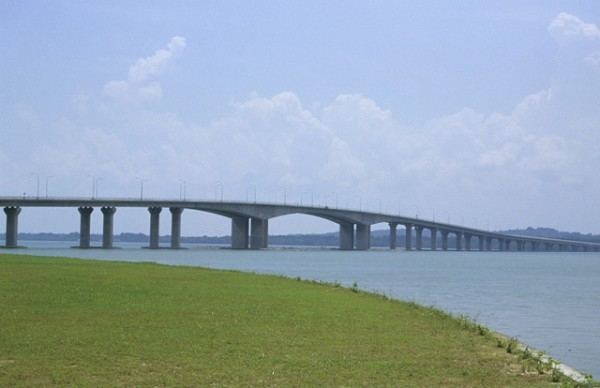 | ||
Maintained by MalaysiaPLUS Malaysia Berhad(Projek Lebuhraya Usahasama Berhad)SingaporeLand Transport Authority (LTA) Similar Woodlands Train Checkpoint, Legoland Malaysia Resort, Johor Premium Outlets, Port of Tanjung Pelepas, Danga Bay | ||
The Malaysia–Singapore Second Link (Malay: Laluan Kedua Malaysia–Singapura) is a bridge connecting Singapore and Johor, Malaysia. In Singapore, it is officially known as the Tuas Second Link. The bridge was built to reduce the traffic congestion at the Johor–Singapore Causeway, and was opened to traffic on 2 January 1998. It was officially opened by Singapore's then Prime Minister Goh Chok Tong with his counterpart, Dr Mahathir Mohamed, who was then Prime Minister of Malaysia. The bridge supports a dual-three lane carriageway linking Kampong Ladang at Tanjung Kupang, Johor to Jalan Ahmad Ibrahim at Tuas, Singapore. The total length of the bridge over water is 1,920 metres (6,300 ft).
Contents
- From Malaysia
- From Singapore
- History
- Tanjung Kupang Toll Plaza Heading into Malaysia
- Tuas Checkpoint heading into Singapore
- Navigational channels
- JohorSingapore International 2nd Link Bridge Run
- Technical specifications
- Public bus transport
- References
At Malaysian side, the bridge is connected to the Second Link Expressway (Malay: Lebuhraya Laluan Kedua Malaysia-Singapura) E3 also known as Linkedua Expressway, which links from Senai North Interchange Exit 253 at North-South Expressway E2, Senai Airport and Taman Perling, Johor Bahru via its extension known as Johor Bahru Parkway E3. In Singapore, the bridge connects to the Ayer Rajah Expressway.
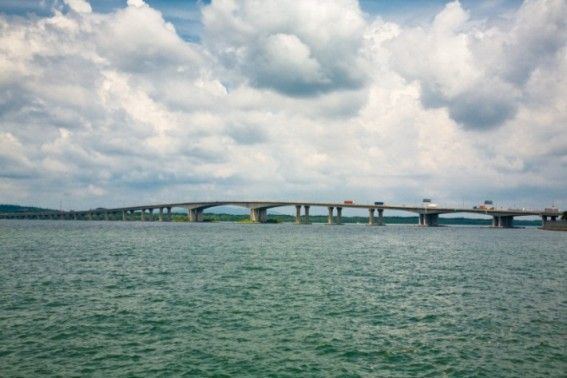
The checkpoint on Malaysia side is called the Sultan Abu Bakar CIQ Complex. The checkpoint on Singapore side, the Tuas Checkpoint, was built on 19.6 hectares (48 acres) of reclaimed land at a cost of S$485 million. Designed by CPG Corporation, it involved the use of 54,000 cubic metres (1,900,000 cu ft) of concrete and 18,000 tonnes (20,000 short tons) of reinforcing steel, and won the Architectural Design Award and Best Buildable Design Award awarded by the Singapore Institute of Architects and the Building and Construction Authority respectively. Travelling along the Second Link usually takes less time than the Causeway due to smoother traffic in both directions; however, during festive periods (especially Chinese New Year, Hari Raya, Christmas and Deepavali) the dense traffic between Malaysia and Singapore still leads to massive jams on both bridges.
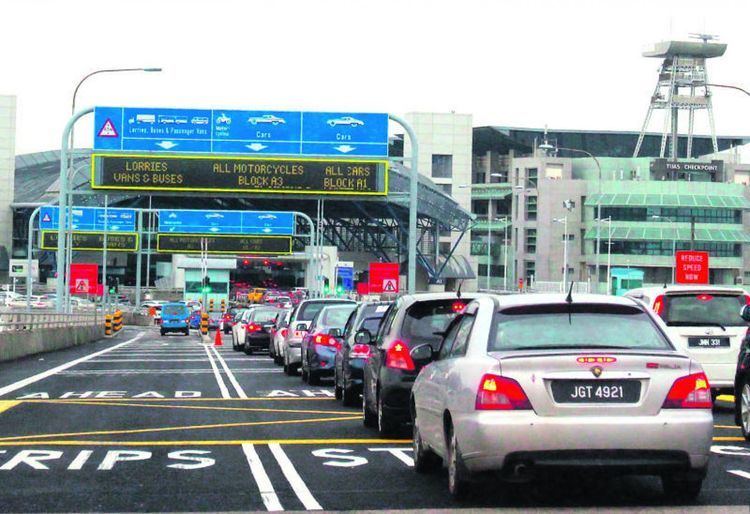
From Malaysia
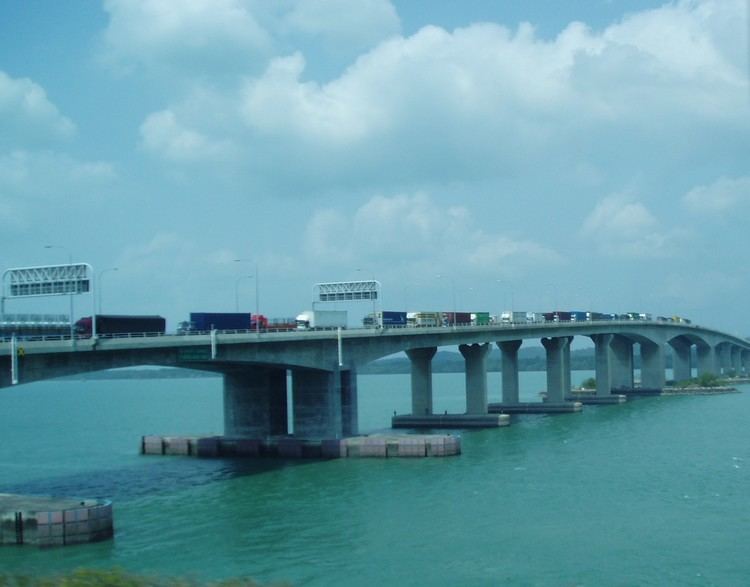
The approach to the bridge is via the Second Link Expressway, which can be accessed by exiting the North-South Expressway (E2) at exit 253 Senai North Interchange. Alternatively, motorists can also enter the expressway via Taman Perling which also joins with Pasir Gudang Highway (Federal route 17 and Skudai Highway (Federal route 1). The expressway link to Taman Perling is also known as Pontian-Johor Bahru Parkway.
From Singapore
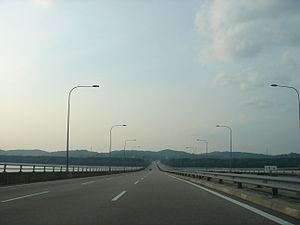
The bridge is directly accessed via the Ayer Rajah Expressway, along with other supporting roads around the vicinity of the Tuas industrial area.
History
The idea of building a second link between Malaysia and Singapore was first raised in July 1980 by then-Menteri Besar of Johor, Othman Saat. Gelang Patah was raised as a viable site due to its distant proximity from Johor Bahru, and the suggestion was raised to tackle growing traffic jams on the causeway. The Malaysian federal Government welcomed Othman's plan, and the Johor State Government formed a committee to study the feasibility of building the second link.
In July 1989, United Engineers Malaysia Berhad (UEM) submitted a proposal to the government of Malaysia to privatise the construction of a second link to Singapore. The acceptance of the proposal brought about the signing of a concession agreement in July 1993, giving exclusive rights and authority to UEM to design, construct, manage, operate and maintain the bridge and expressways for a period of 30 years commencing 27 July 1993.
Following this, a novation agreement was executed in May 1994, whereby UEM assigned all its rights, liabilities and obligations in respect of the concession agreement to Linkedua (Malaysia) Berhad, a wholly owned subsidiary of UEM.
The construction of the bridge required the co-operation of the government of Malaysia and the government of the Republic of Singapore. On 22 March 1994, an inter-government agreement was signed defining the responsibilities of both governments with regard to the design, construction, operation, and maintenance of the bridge. Each government was responsible for the construction of the portion the bridge which fell within its borders, based on a common agreed design. A joint committee comprising representatives of each government was formed to oversee the implementation of this Malaysia-Singapore Second Crossing project.
The major components of the project are the Second Crossing bridge, forty-four kilometres of expressways, a Customs, Immigration and Quarantine complex, three toll plazas, two rest and service areas and other ancillary facilities. The bridge was designed to accommodate up to 200,000 vehicles a day.
The Second Link was opened to traffic on 2 January 1998. It was officially opened on 18 April the same year by the Prime Ministers of both countries, namely Dato' Seri Dr. Mahathir Mohamad of Malaysia and Goh Chok Tong of Singapore. The Malaysia-Singapore Second Crossing heralded a new era in bilateral relations, and brought with it the promise of improved economic and social ties.
Tanjung Kupang Toll Plaza (Heading into Malaysia)
U-turn fees are also applicable (for U-turn back to Malaysia).Singapore dollar is also accepted but at the rate of 1:1 (i.e. Pay S$1.00 for RM1.00)Payment is made by Touch n Go card, and also by SmartTAG. Cash payments are not accepted.Tuas Checkpoint (heading into Singapore)
(Fees reduced by 30% on 1 August 2010)
Payment is made by Autopass card (Malaysian registered vehicles only), EZ-Link, NETS CashCard or NETS FlashPay (CEPAS Cards applicable). Cash payments are not accepted.Navigational channels
When travelling by sea, navigational aids consists of lights mounted on the bridge piers and lighted buoys placed at strategic navigational locations. The three sea channels dimensions are 75 metres (246 ft) wide by 25 metres (82 ft) high; 50 metres (160 ft) wide by 9 metres (30 ft) high; and 75 metres (246 ft) wide by 12 metres (39 ft) high.
Johor–Singapore International 2nd Link Bridge Run
Since 1999, an annual 2nd Link Bridge Run is organised to promote sports and cross-border ties. Both countries take turns to host the event that has seen increasing numbers of participants.
Technical specifications
Bridge Specifications
Navigational Channels
Public bus transport
Causeway Link Route CW3 from Malaysia goes into Bukit Indah via Tuas Checkpoint from Jurong East Bus Interchange in Singapore.
Service 182 from SBS Transit calls at the bus stop outside Tuas Checkpoint but it does not cross over at Malaysia due to the height limit restrictions.
Service 182M plies the exact route of Service 182 without calling at the bus stop outside Tuas Checkpoint.
